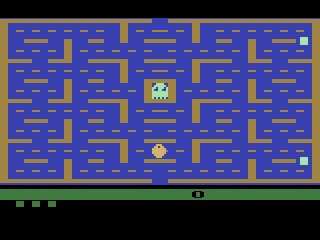|
|
Pac-Man
|
Name:
|
Pac-Man |
 |
| Company: | Atari | |
|
Model #:
|
CX-2646 | |
|
Programmer:
|
Tod Frye | |
| Year: | 1981 | |
|
Released?
|
Yes
|
|
|
Notes:
|
Released on ‘Pac-Man Day’ April 3rd 1982 |
Along with E.T., the Atari 2600 version of Pac-Man will long be known as one of the bigger disappointments in the 2600's game library. At the time of its release, Pac-Man was the most popular arcade game in the world, and therefore was Atari's hottest license. After being hyped to death for months, Pac-Man was finally released to eager 2600 fans on what was declared Pac-Man Day (April 3rd 1982). The response was unanimous, for Pac-Man fans everywhere were shouting "What the heck? This doesn't look like Pac-Man!"
The 2600 version of Pac-Man can best be described as 'adequate'. Had it been any other game Atari fans would have passed it off as another 'average at best' conversion and moved on, but this wasn't just any game, it was Pac-Man! Atari had botched the most popular game in history and for 2600 fans everywhere there was just no excuse. After the months of hype, the advertisements stating that no other system would have Pac-Man, and the promise of everyone's favorite game coming home, Atari fans felt betrayed. Everyone wanted to know the same thing; what happened to Pac-Man, and why didn't Atari fix it?

These questions are a bit hard to answer. There are many rumors floating around that have been retold so many times that they're now considered firm facts. I'll attempt to address the most prominent myths here:
1. Tod purposely botched Pac-Man because he was already promised a huge royalty and didn't care about the quality after that.
2. Tod had an amazing 8K version of Pac-Man up and running by Atari forced him to strip it down to fit on a 4K cartridge.
3. Tod held the half-finished prototype for ransom until Atari agreed to give him a giant royalty to finish it, knowing that they couldn't find another programmer in time for the crucial Chirstmas holidy.

As I mentioned before, all three of these rumors are completely false. The first rumor implies that Tod got his royalty agreement before he finished Pac-Man and didn't care about its quality. This is incorrect as Tod (and several other Atari employees) started getting game royalties in order to keep them from jumping ship to other companies and didn't receive them until after Pac-Man was done. Tod was also on probation at the time, so he made sure that he put a lot of work into Pac-Man (the quality is due to it being his first game). The second rumor sounds believable at first glance since other programmers had passed on Pac-Man due to it having to fit into 4K, but Tod designed the game to be 4K from the get go. There was never an 8K version. The last rumor is the most oft repeated one, but it too us false as Pac-Man was released in April and never intended to be a Christmas title (the game wasn't finished until September, far too late for Christmas).

So why do these rumors keep circulating? There are two main reasons: 1. People need a reason to explain why their favorite game wasn't the best it could have been. and 2. Tod Frye has a mystique about him as he was the programmer for a large number of unreleased games and was known to be a 'character' around Atari. For this reason it's not too hard to believe some of these rumors might be true. It wasn't until recently that Tod set the record straight when he was interviewed for the book "Atari Inc: Business Is Fun".
The bottom line is that the 2600 version of Pac-Man, while adequate, isn't all that good. Atari made much better versions of Pac-Man for the Atari 400/800, 5200, Intellivision, and Colecovision (under the Atarisoft label), but the 2600 version is the one most people remember. At first Pac-Man sold fairly well, but once word of mouth got around about how bad the port was sales started to drop off. To add insult to injury, Atari produced more Pac-Man carts than there were 2600's in existence with the logic being that Pac-Man would sell 2600's all by itself (although it's rumored that one Atari exec said that people would want to buy more than one copy to keep at all their vacation homes). Unfortunately by the time of the crash Atari literally had millions of unsold Pac-Man carts sitting in its warehouses. Pac-Man served as a wakeup call to Atari that 2600 fans wouldn't buy just anything with a popular name attached to it, a lesson Atari would soon learn with another little game called E.T..
| Version | Cart Text | Description |
| ?????? | Pac-Man EPROM Cartridge | Final Version? |


